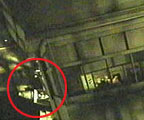| |
 Monsanto's
Adventure Thru Inner Space: The Monsanto Company, tiring of their
sponsorship of the House of the Future, appealed to the Imagineers
for something more dramatic than plastic toilets and microwaves,
and their original plans for "Adventures in Science" evolved
quickly into an "Adventure Thru Inner Space," which opened
at Disneyland on 5 August 1967. The prime motivator of this expedition
was Dr. Charles Allen of Monsanto. Alternate titles considered for
the attraction included "Micro-World" and "The Magic
Microscope". For those of our readers too young or underprivileged
to have taken this adventure, it consists of using the "Mighty
Microscope" to shrink you down to the size of crystals, then
molecules, then atoms, and beyond. One interesting note is that
the Mighty Microscope stood in almost exactly the same spot as did
the giant telescope when the building housed Kaiser's Hall of Aluminum
Fame through July of 1960. Narration for the attraction was supposedly
the "suspended thought waves" of the first guest to travel
through the Mighty Microscope. Monsanto's
Adventure Thru Inner Space: The Monsanto Company, tiring of their
sponsorship of the House of the Future, appealed to the Imagineers
for something more dramatic than plastic toilets and microwaves,
and their original plans for "Adventures in Science" evolved
quickly into an "Adventure Thru Inner Space," which opened
at Disneyland on 5 August 1967. The prime motivator of this expedition
was Dr. Charles Allen of Monsanto. Alternate titles considered for
the attraction included "Micro-World" and "The Magic
Microscope". For those of our readers too young or underprivileged
to have taken this adventure, it consists of using the "Mighty
Microscope" to shrink you down to the size of crystals, then
molecules, then atoms, and beyond. One interesting note is that
the Mighty Microscope stood in almost exactly the same spot as did
the giant telescope when the building housed Kaiser's Hall of Aluminum
Fame through July of 1960. Narration for the attraction was supposedly
the "suspended thought waves" of the first guest to travel
through the Mighty Microscope.
Adventure Thru Inner Space is a landmark Disney attraction because
it was the very first use of the Omnimover ride system, now widespread
in the parks. This system has many names: atommobiles in this first
application, Doom Buggies at the Haunted Mansion, Time Machines
at Spaceship Earth, (Disney World) and many more to come. Omnimover
systems consist of an endless chain of small vehicles, each with
a thin blade extending from the bottom. Pairs of tires spotted along
the track move the chain, much like the tires of the old PeopleMover
propelled those vehicles. Omnimovers have the ability to rotate,
and this is used to focus guests' attention on the scenes of interest
(and distract them from the boring parts). Each vehicle also has
its own soundtrack, with any number of sound cues triggered by certain
points on the track so the sound will stay in fair synch even after
one of those unmentionable stops.
One of the unfortunate side effects of this attraction. Being as
it was free, the lines were short, and the sense of privacy offered
by the atommobiles encouraged quite a number of activities not generally
considered to be appropriate at a Disney Park. Disney installed
closed circuit TV cameras in the ride. The cameras weren't put in
to serve the prurient interests of the cast members, but to help
apprehend those miscreant guests who leaned out of their atommobiles
to touch, break, spit on (the eye at the end of the ride), or remove
the set pieces. It was quite a difficult problem for this attraction,
and led Imagineering to develop the concept of the "Envelope
of Protection." While many, on hearing the term, may think
it refers to the protection of the guests, it actually refers to
the necessary distance between the guests and the set for the protection
of the set. The application of the "Envelope of Protection"
dimensions to subsequent attraction designs has resulted in much
reduced maintenance, albeit at the cost of somewhat less intimacy.
Too bad the distance wasn't enough to keep the kids from spitting
on the eye at the end!
 September,
2nd 1985, was the last day the Mighty Microscope shrank a guest,
and the romantic opportunities in the park haven't been the same
since. While much of the Plexiglas and Lexan sets were trashed,
the Mighty Microscope survived (in a minature model recreation that
is), and the sharp-eyed visitor to Star
Tours might just be able to spot it during their trip. September,
2nd 1985, was the last day the Mighty Microscope shrank a guest,
and the romantic opportunities in the park haven't been the same
since. While much of the Plexiglas and Lexan sets were trashed,
the Mighty Microscope survived (in a minature model recreation that
is), and the sharp-eyed visitor to Star
Tours might just be able to spot it during their trip.
The above information was found at: http://www.emuck.com/aotw/inner.htm
|
|